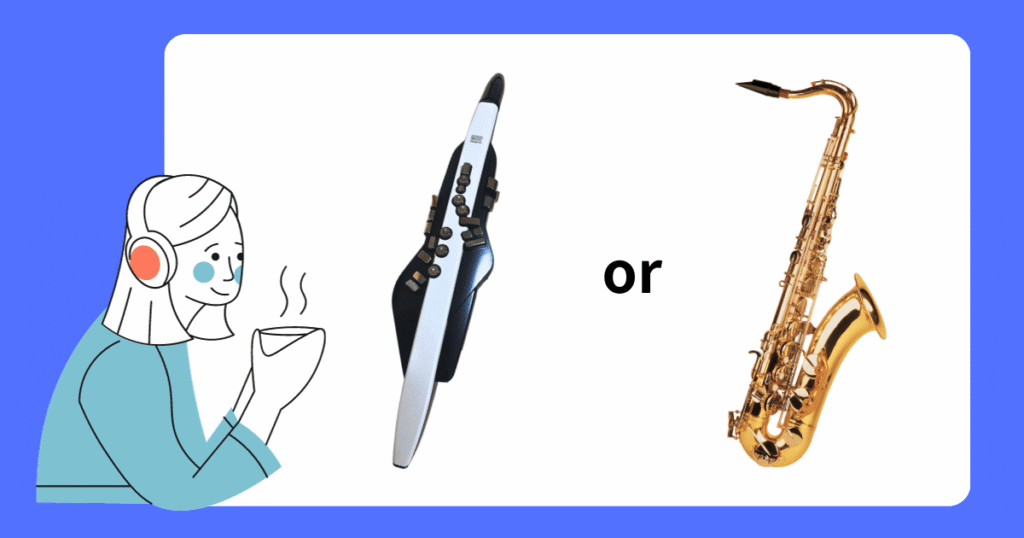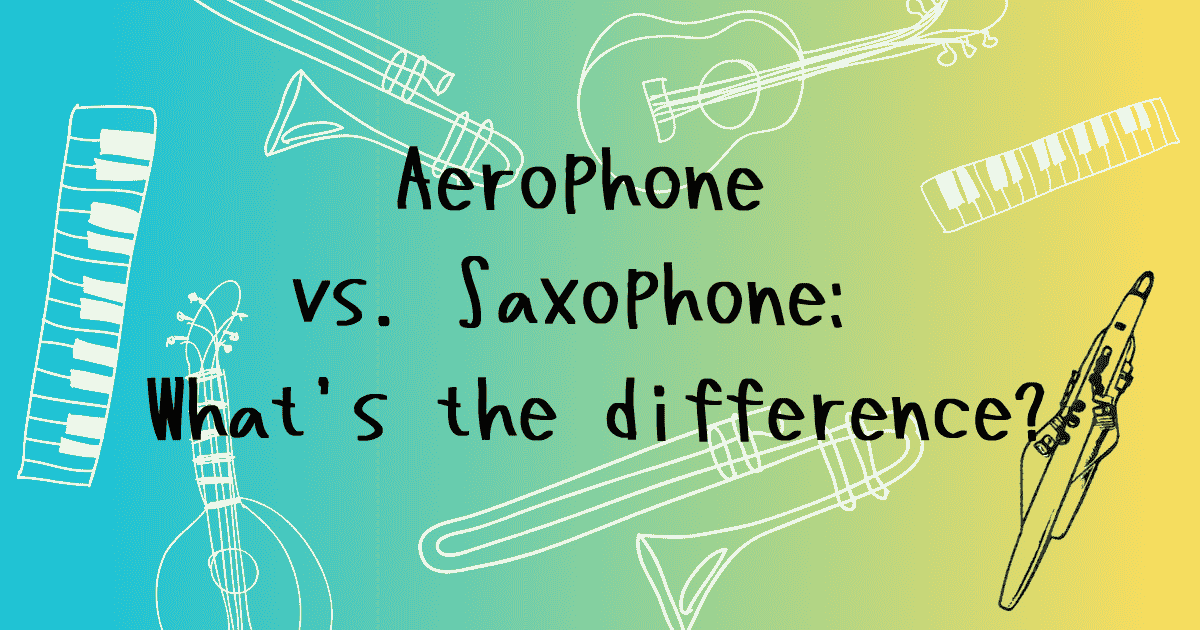Hi, I’m Shuko.
After I’d been learning the Aerophone for a little while, I had the chance to try playing both an acoustic alto saxophone and a tenor saxophone just for fun.
Today, I’d like to share the differences I noticed at that time.
If you’re a saxophone player, this might all seem pretty obvious—but I hope you’ll enjoy reading the impressions of a complete beginner to wind instruments with an open heart.
My conclusion?

They’re similar… but totally different.
Of course, the saxophone is a fantastic instrument.
But at the same time, I want more people to know that the Aerophone is also an amazing instrument in its own right.


A Longing for Acoustic Instruments
As I mentioned in my article “Types of Digital Wind Instruments and How to Choose One,” many Aerophone users are actually saxophone players.
For them, digital wind instruments are a familiar extension of their main instrument.
They’re often used for practicing at home or even for live performances by professional musicians.
In many cases, digital wind instruments are seen as a kind of “secondary” option—and I came across this kind of perspective quite a lot.
Reading things like that, I started to wonder if acoustic instruments were somehow better.
For a while, I even found myself unconsciously looking down on the Aerophone a bit.
So when I first started learning the Aerophone, I also thought it might be a stepping stone—and that one day I’d want to move up to the saxophone.
With that in mind, I asked my teacher if I could try playing both an alto and a tenor saxophone.
That one time was the only time I’ve ever actually played an acoustic saxophone—but the experience left a deep impression on me.
It was so powerful and vivid that I still remember it clearly to this day.


My firsthand impressions of the differences
The Weight
First of all—these instruments are heavy!
Compared to the Aerophone, which weighs about 1kg, an alto sax weighs around 2.5kg, and a tenor sax can be anywhere from 3 to 4kg.
The strain on your neck and shoulders is totally different.
It felt really heavy!
Sitting down to play might be manageable, but I was shocked to learn that most people perform standing up at recitals.
No Sound Came Out
When I first played the Aerophone, I was able to produce a sound right away just by blowing into it.
But with the saxophone… nothing.
The issue was how I was placing the mouthpiece in my mouth—my embouchure.
While the Aerophone has a reed-style mouthpiece, it’s made entirely of plastic, so even if you bite down a bit, the airflow isn’t blocked.
But with a real saxophone reed, if you bite down (which might also depend on how the reed is attached), the airflow can get completely cut off.
No matter how hard you blow, no sound will come out.
That was the moment I truly understood what it means for a reed instrument to produce sound by vibrating the reed.
Not Enough Air
Once I managed to get past the embouchure issue and could make a sound, I ran into a new problem: I didn’t have enough breath support or airspeed to play steadily.
Since the Aerophone doesn’t need tuning, I’d never experienced what it’s like to try to hit a note and completely miss the pitch.
This was my first time realizing that.
Getting a good sound out of a saxophone is much harder than I imagined.
Volume & Vibration Through the Instrument
I expected the saxophone to be loud, but what really surprised me was how much I could feel the vibration of the instrument through my body.
It felt like the instrument became part of me—especially with the tenor sax, the warm low tones resonated gently through my body in a way that was incredibly satisfying.
They’re similar… but totally different.
After trying both the alto and tenor saxophones, I realized that while the Aerophone is similar to the sax, it’s really a different instrument altogether.
What saxophonist Mana Arakawa said on YouTube—“It lets you practice in a saxophone-like way”—really resonated with me.
That phrase really sums it up perfectly.
Why the Aerophone Still Inspires Me


After that experience, I thought my longing for acoustic instruments would only grow stronger.
But as I continued practicing, I began to discover just how fascinating and deep the Aerophone really is—and before I knew it, I found myself wanting to master it even more.
I’d like to share both the realistic reasons why I decided to let go of the idea of playing the saxophone, and why I chose to stick with the Aerophone instead.
Why I Let Go of the Saxophone
① It’s Too Heavy for Me
Since I already get shoulder pain with the Aerophone, I quickly realized that the saxophone is just too heavy for me to handle.
② I Can’t Practice at Home
When it comes to the saxophone, everyone finds creative ways to practice.
Some rent community halls, others rent lesson rooms, and some even practice by the riverbank.
The saxophone definitely requires a specific place to practice.
I really admire how people manage to do that with such a heavy instrument. It’s something they can do because they love it.
However, for someone like me—who tends to be a bit of a homebody and not too keen on going out—I figured it would be too difficult.
Why I Decided to Keep Going with the Aerophone
① The Sound My Teacher Plays is Beautiful
I feel like it might be a bit disrespectful to compare myself to my teacher, but when I hear their example performances during lessons, the quality of sound is completely different from mine.
There’s still a lot of room for improvement in things like my embouchure, fingering, and breathing technique.
I realize I have so much potential to grow, and it’s made me want to play even more beautifully!
② There Are So Many Different Tones
I always thought I’d want to play the tenor sax if I were to pick up the saxophone, but it was too heavy and difficult for me, so I gave up on that.
However, with the Aerophone, I can still play the sound of the tenor saxophone I’ve always admired.
On top of that, it has over 250 different sounds, and I can play music beyond just saxophone sheet music.
Transposing is also easy, so for example, I can play an E♭ (E-flat) saxophone sheet in a flute sound.


So, that’s the shock I experienced from trying the saxophone, and the reasons why I’ve decided to continue with the Aerophone.
Just like how some people enjoy playing on easy mode in games rather than hard mode, I’ve come to believe it’s all about choosing what works best for you.
Realizing the charm and depth of the Aerophone has made me stop caring about whether people might think, “Oh, it’s just an Aerophone.” (Though I might be a little overly self-conscious!)
Now, I genuinely enjoy practicing the Aerophone and getting better at it.
In the end, my somewhat distorted admiration for the saxophone, thinking “Maybe it’s better than the Aerophone,” has transformed into a pure, sparkling admiration for the saxophone, seeing it as truly wonderful.



For now, I’ll stick to enjoying the saxophone as a listener.


Summery
The Aerophone and the saxophone are similar, but they are different instruments.
If, after reading this article, you find yourself thinking, “It’s definitely the saxophone for me!” then I encourage you to go ahead and play the sax. It’s truly an amazing instrument.
At the same time, I want more people to know just how fantastic the Aerophone is as well.
If you’re interested in digital wind instruments like the Aerophone but aren’t sure whether to take the plunge, I highly recommend giving it a try.
Just like how electronic pianos have firmly established their place in the music world, I hope digital wind instruments will become widely recognized for their own unique charm.
Thank you for reading until the end!


